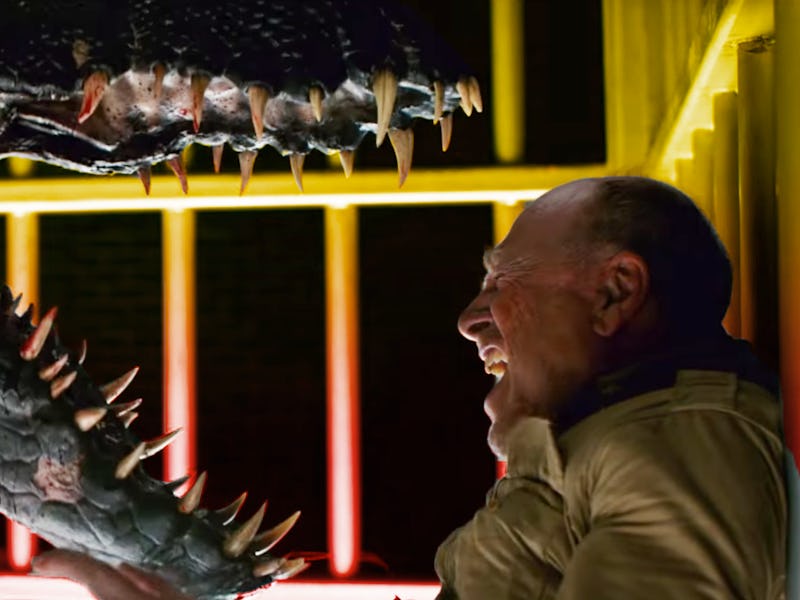Where Does the 'Jurassic World' Series Even Go From Here?
Goodbye dinosaurs, hello monsters.

Jurassic World: Fallen Kingdom was pretty clear about its intentions to blow up everything fans had grown to take for granted in the Jurassic franchise. The first trailer showed the island explode, and the tagline on the posters read “the park is gone.” By the end of the movie, dinosaurs have escaped into the wilds of Northern California, with the implication being that these extinct creatures are now truly going to make Earth a Jurassic world. The ending opens up a ton of possibilities for Jurassic World 3 and beyond, but at what cost?
Is the Jurassic franchise just another series of monster movies now?
Sure, the Jurassic movies have always been about giant, scaly beast with razor-sharp fangs and claws who hunt, kill, and feast upon the flesh of unlucky characters, but until Fallen Kingdom they haven’t felt like “monsters.” Now that the dinosaurs are no longer exhibits — a wonder (and danger) that people must travel to behold — they feel more like generic beasts in the wild. If the future of Jurassic World is that dinosaurs are everywhere, and just a fact of life, then what makes them remarkable?
The first Jurassic Park is a masterpiece, a true showcase of Steven Spielberg’s mastery of craft, emotion, suspense, and dinosaurs. What Spielberg really nails is the sense of awe and majesty. That’s what makes the dinosaurs in Jurassic Park stand out and endure.
All the King Kong movies have dinosaurs, Journey to the Center of the Earth has dinosaurs, but the JP dinos are special. When Alan Grant, Elle Sattler, and Ian Malcom first see the Brachiosaurus, and John William’s iconic theme music swells, viewers are seeing the dinosaurs through the characters’ eyes, and we’re as amazed as they are.
Jurassic Park didn’t just capture how frickin’ scary it would be to have Velociraptor chase you, it also captured how incredible it would be to see a living dinosaur. Even after seeing five Jurassic movies, chances are you’d still consider going to Jurassic Park if one opened IRL.
It’s this wonder that elevates Jurassic Park and makes the chaos the dinosaurs unleash when things go south that much more meaningful. The first Jurassic World arguably worked best during its first half, because it was the first time in the series that anybody had truly seen a working version of the park. It really felt like an incredible experience.
Fallen Kingdom is full of spectacle — the eruption scene shown from inside the gyrosphere is legitimately thrilling — but there’s not much majesty. Rather than showing us how awe-inspiring these creatures are, Fallen Kingdom just tells us. These aren’t wonders anymore, they’re auction items. A dinosaur is worth $4 million, this movie explicitly says, which is less than a fortieth of what Fallen Kingdom cost to make.
The humans in Jurassic World: Fallen Kingdom have plenty of empathy for the dinosaurs, but any good monster movie knows to give its monster a softer side. Even so, Fallen Kingdom is the first movie in the series — barring the forgettable Jurassic Park III — where the dinosaurs aren’t something you’d be excited to see in real life. They’re cool, sure, but they’re mostly just scary props.
There aren’t many details about what Jurassic World 3’s plot will be, but the movie will focus on a world where dinosaurs live in the wild, and could be lurking around every corner. It’s looking like the franchise is now going to be about the downfall of mankind, as Ian Malcom so ominously predicted. That’s interesting, even if it is straight-up the plot of the new Planet of the Apes movies.
Jurassic World 3 will probably be exciting and it will almost certainly make obscene amounts of money at the box office. But by pivoting to a story about genetics run amok and monsters lurking in the wild, we’ll lose that sense of wonder of an impossible wish being fulfilled that made the original film so special.
Jurassic World: Fallen Kingdom is now in theaters.